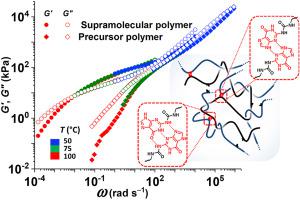Polymer ( IF 4.6 ) Pub Date : 2020-10-06 , DOI: 10.1016/j.polymer.2020.123117 Mostafa Ahmadi , Mohammad Ghanavati

|
Self-healing is a nature-inspired characteristic that is imparted in synthetic polymeric materials through the integration of reversible supramolecular bonds following different design concepts. Generally, the dynamics of supramolecular bonds regulates timescale of the self-healing process, specifically in polymeric systems with a homogeneous morphology. Herein, we explore the utility of guanine as a hydrogen bonding group to construct supramolecular polymeric systems based on poly (n-butyl methacrylate). For this purpose, we follow a three-step reaction approach, including a living radical copolymerization, deprotection of the functional comonomer, and grafting of the guanine group. The microstructure of obtained samples is assessed at each step by a combination of 1H NMR, FTIR, and GPC, and the homogeneity of morphologies is realized from the lack of secondary thermal transitions in DSC thermograms. To discover scaling concepts that govern such supramolecular materials, we systematically vary the structural parameters, including the chain length and the fraction of associative groups, and investigate their responses to the oscillatory shear deformation. The relaxation dynamics becomes significantly slower upon the introduction of transient bonds, which gets even more hindered when the chain length or the fraction of supramolecular groups are increased, following the scaling laws derived from the sticky reptation mechanism. Moreover, despite rheological measurements reveal that the network recovery after large deformations is not immediate, samples could completely heal a macroscopic scratch at 40 °C within 24 h, which is promising for the development of self-healing adhesives and coatings.
中文翻译:

自修复超分子鸟嘌呤改性的聚(甲基丙烯酸正丁酯-甲基丙烯酸共羟乙酯)共聚物的动力学
自修复是一种自然启发型的特性,通过遵循不同的设计理念,通过可逆超分子键的集成,在合成聚合物材料中赋予了这种特性。通常,超分子键的动力学调节自我修复过程的时间尺度,特别是在具有均相形态的聚合物体系中。在本文中,我们探索了鸟嘌呤作为氢键基的用途,以构建基于聚甲基丙烯酸正丁酯的超分子聚合物体系。为此,我们遵循三步反应方法,包括活性自由基共聚,功能性共聚单体的脱保护和鸟嘌呤基团的接枝。在每个步骤中,通过组合1对获得的样品的微观结构进行评估1 H NMR,FTIR和GPC以及形态的均一性是由于DSC热分析图中缺少二次热转变而实现的。为了发现控制此类超分子材料的尺度概念,我们系统地改变了结构参数,包括链长和缔合基团的分数,并研究了其对振荡剪切变形的响应。引入瞬态键后,弛豫动力学变得明显变慢,当遵循粘滞复制机理得出的定标定律时,当链长或超分子基团的比例增加时,松弛动力学会受到更大的阻碍。而且,尽管流变学测量表明大变形后网络恢复不是即时的,



























 京公网安备 11010802027423号
京公网安备 11010802027423号